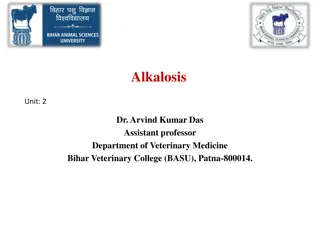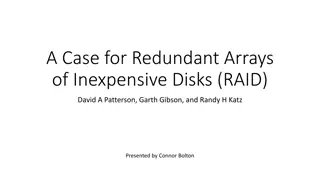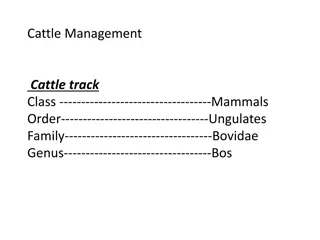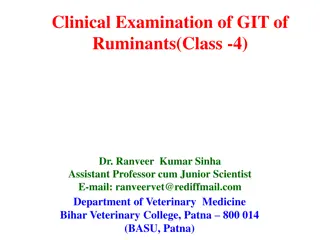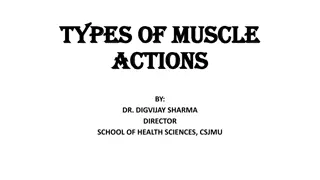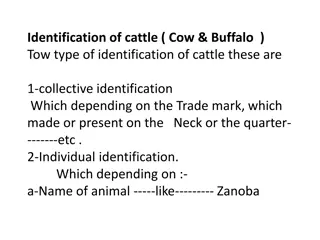Feasibility Study: Measuring Ruminal Contractions of Cattle Using an Inexpensive Electronic Veterinary Stethoscope
Effects of gastrointestinal motility in understanding disease and nutrition in cattle are actively researched. This study explores monitoring ruminal contractions using a cost-effective electronic stethoscope. The device, developed with Arduino technology, showed promising results in capturing internal noises from cattle. Ruminal contractions can indicate a cow's health status and this instrument holds potential for research by animal nutritionists and veterinarians.
Download Presentation

Please find below an Image/Link to download the presentation.
The content on the website is provided AS IS for your information and personal use only. It may not be sold, licensed, or shared on other websites without obtaining consent from the author.If you encounter any issues during the download, it is possible that the publisher has removed the file from their server.
You are allowed to download the files provided on this website for personal or commercial use, subject to the condition that they are used lawfully. All files are the property of their respective owners.
The content on the website is provided AS IS for your information and personal use only. It may not be sold, licensed, or shared on other websites without obtaining consent from the author.
E N D
Presentation Transcript
Feasibility Study: Measuring Ruminal Contractions of Cattle Using an Inexpensive Electronic Veterinary Stethoscope By Adam Manaster, Divya Aggarwal, and Yaashnaa Singhal
Overview The effects of gastrointestinal motility in understanding disease and nutrition in cattle has been an active area of research. One methodology for monitoring the health of cattle involves studying contractions of their stomach. Traditional veterinary and electronic stethoscopes are available for these purposes, but can be costly. However, this feasibility study aims to provide graphical data for ruminal contractions in cows by employing an inexpensive electronic microphone with a 3D-printed stethoscope head. This electronic stethoscope was used for data acquisition at the Beef and Sheep Research Field Laboratory located at the University of Illinois at Urbana-Champaign. A second microphone was used to gather background noise. The data from the electronic stethoscope showed distinct peaks in the amplitude graphs that were absent from the background microphone data. Despite extraneous variables, like the physical shifting of the main microphone against the cow and movements of the cow itself, the graphs are strongly suggestive of internal noises from the cow, possibly ruminal contractions. This instrument is promising and presumably could be used by animal nutritionists and veterinarians alike in their research.
Introduction The makeshift stethoscope we created is intended to measure gastrointestinal noises in a specific compartment of a cow s stomach known as the rumen. The goal of this feasibility study is to measure ruminal contractions of large cattle using an electronic stethoscope. The device was developed from an Arduino Mega 2560 microprocessor and electret microphone amplifiers on a printed circuit board, which was programmed using the code from Professor George Golin s code repository on the course website for PHYS 398 DLP at UIUC. Two microphones were implemented in the data collection process: one monitored the internal ruminal movement of the cow test subject and the other was used to pick up on environmental background noise in the farm where we collected data.
Internal Workings of a Cow The synchronized movement of the rumen and reticulum aid in mixing the ingested food and passing it into the omasum (refer to figure on next slide). This is done by cyclical contractions of the different chambers of the cow that occur for the reticulum every 50 - 70 seconds. Certain complications with the vagal nerve and the muscles of the rumen undergo low amplitude intrinsic contractions and the movement of the rumen stagnates and the animal can die. A healthy cow usually undergoes 1-2 ruminal contractions during this time period; hence, ruminal contractions can indicate whether or not the cow is healthy.
Motivation When it comes to studying the health of cattle, the primary research method involves surgically cutting a sizable hole in the cow s side and placing a rubber cylinder there in a process known as cannulation. This method is expensive, invasive, and limits the number of cows that can be examined. Electronic stethoscopes (e.g. Whisper) are also available on the market, but their primary purpose is to study lung noises in cattle and they tend to be quite costly. Our study addresses these drawbacks by using a 3D-printed electronic stethoscope that is sensitive enough to measure the movement of the rumen.
Cannulated cows: This research method of studying the rumen is highly invasive and costly since a proper surgery needs to be done. Furthermore, it is not practical for studying a huge number of animals. A snapshot from the research paper we were given.
Methods (1) After testing our breadboard, we moved our components to a PCB, which was distinctly less noisy. We measured our heartbeats before visiting the Beef and Sheep Research Farm to take data on cows on Friday (3/13/20). We were instructed by a veterinary scientist (Courtney Hayes) who also helped us to place the stethoscope head on the left sublumbar fossa where palpitations are most observable. A clenched fist can be pushed in this area to assess rumen flow. The contractions felt at the left sublumbar fossa can be heard by a stethoscope, which is the most sensitive method of hearing ruminal contractions . Hence, for this study we chose this region to place the main microphone. Data were collected in 5-7 minute time windows, taking 4 trials. We chose this time period to see some sort of pattern since Dr. Courtney Hayes, our consulting veterinary scientist, said there are usually 2-4 contractions every 2 minutes.
Methods (2) The background microphone, held about a foot away from the main microphone, kept track of the background noise. We took data on the cannulated and non-cannulated cow; however, for this study, we chose to work work with data from the non-cannulated cow since the data we collected was easier to work with and less noisy. A smartphone was used to make audio recordings during the trials so that we could keep a record of the background noises.
Some Quirks of Field Data-Collection... The barn was quite noisy, primarily due to the wind. The cow would also move often and sing to itself. A grad student worker, who helped us in the data-collection process, suggested we let a calf feed from the cow so that the cow is stable enough for us to work with. Making sure the calf didn t stamp over our feet, while we stood as still as possible to not move the microphones too much, was also a subtle caveat.
Materials Arduino Mega 2560 Microphone (Main) BME 680 Microphone (Background) (A1, GND, C10 - capacitor for the main microphone) MicroSD Card Potentiometer Keypad Capacitors (7 in total) LCD Red LED Indicator (to determine whether the PCB was on) Precision I2C RTC INA219 DC Current Sensor Button (to turn PCB on and off) AA Battery Pack Resistor
Software and Data Acquisition (1) The noises we were attempting to monitor are at a low frequency, we wanted to block out as much background noise and static originating from the microphone. To accomplish this, data was read from both the microphones into a microSD as binary file. One data point from the main and the other from the background microphone and so forth. Wav files are created from the binary file by creating two distinct arrays for background and main and then subtracting the two arrays so that the main microphone data is mostly clear of the background noise. However, before this subtraction occurs, a gain correction factor was applied to the background microphone array. This factor essentially adjusts the sensitivity of the background microphone to match that of the main microphone because the two microphones possessed different gains (meaning they each had different audio input levels, albeit not by much). We calculated the gain correction factor (utilizing Python code) by sampling audio in a silent room and using the data from each microphone to determine the relative ratio of the RMS from both arrays. We determined the value to be about 0.9 (i.e. the gain of the background microphone was 0.9x that of the main microphone).
Software and Data Acquisition (2) The program that we uploaded to our Arduino Mega 2560 (which is connected to the PCB) logs data from two distinct ADC channels to a binary file. Both of these ADC channels house an electret microphone. The sampling rate of each separate channel is 16 kHz (meaning 16,000 samples are recorded per second). The raw ADC count data (from 0 to 1023) are written to buffers (of which there are 13 in total), which are in turn used to write the audio file. Each buffer used in this process can hold 512 bytes of information. Once these buffers are at maximum capacity or the program is stopped, they are written to the output file. This output file is written and subsequently saved to the 8 GB microSD card.
Data Processing in Python The resulting binary file is filled with interleaving data from the two microphones. Basically, one sample is recorded from one of the microphones and written to the buffer and then the next sample is recorded from the other microphone and written to the buffer as well. Data are read from the binary file with the assumption that the file contains interleaved analog reads of two ADCs. Thus, two distinct arrays are created for the separate channels (using numpy), where each array contains every other element from the input file. In simpler terms, one array contains the even entries while the other array contains the odd entries. The median, mean, maximum, minimum, amplitude (with respect to the median), and root- mean-square (RMS) of the arrays are subsequently calculated in the code we used.
This figure illustrates that we gathered internal noises from the cow. In this second time span, we see a sharp spike that is not part of the background noise.
Data Analysis LibROSA is a Python package used for music and audio analysis. Its primary role can be seen as a music information retrieval system. The first step of the data analysis was to visualize our audio file as an amplitude envelope, which is a visualization of the changes in the amplitude as a function of time. To visualize Adam s heartbeat, we plotted amplitude envelopes in which we see periodic peaks, which are the heartbeats. We corroborated this by listening to the generated wav file and heard distinct heartbeats that corresponded with the same time stamps as the peaks in the graphs.
Data Analysis Next, we plotted a spectrogram using LibROSA as well. A spectrogram is a visual representation of the spectrum of frequencies of a sample audio as it varies with time. It can be seen as a heat map of the varying frequencies in different colors. We changed the y-axis (which represents the frequencies) to a logarithmic axis to better visualize the range of the frequencies. This was also done to better identify the sounds we were recording through their respective frequencies. The unit of time is in seconds for the x-axis. We plotted Adam s heartbeat as a spectrogram as well. .
Results The background microphone dataset was adjusted for the differences in the gain between both microphones (using the gain correction factor, as previously discussed). Sudden spikes in both of the plots likely indicate the presence of loud environmental noises at a given point in time in the barn where data were being collected. However, jumps in solely the main microphone readings imply that the noise it picked up either came from moving the microphone on the cow s stomach during the data-taking process or internal noises from the cow.
Summary The data plotted from the main microphone, which was placed near the rumen of the cow, showed distinct peaks that were not present in the background microphone dataset. Supplementary audio recordings from a smartphone also did not pick up on any background noise for the time periods where distinct spikes in the amplitude profiles were observed. However, further studies can be performed to discern ruminal contractions with other noises that the cow may be making (both externally and internally). In the future, adding another microphone to collect gastrointestinal noises from the cow and comparing data gathered from both of them versus the background microphone might be more conclusive. Additionally, the gain levels of the background microphone and main microphone need to be more fine-tuned in order to eliminate any offset.
Acknowledgements We would like to acknowledge Dr. Joshua McCann for teaching us about the science behind the ruminal contractions of cattle, setting up our visit to the research farm, and his willingness to provide aid for us throughout this process. We would also like to acknowledge Courtney Hayes for her assistance in helping us determine the optimal way to take data while at the research farm, and we would like to acknowledge Cody Dawson and Leon Peters for their assistance in showing us around the research farm and gathering the cattle. Lastly, we would like to extend our gratitude to Professor George Gollin, Justin Languido, and Charlie Steiner for providing us with the proper resources and knowledge to successfully complete this project.
References [1] Ruckebusch Y., Motility of Gastro-Intestinal Tract [2] Bruno R., Jordan E., Hernandez-Rivera J., Lager K. (2011). The Basic Clinical Exam: Key to Early Identification of Sick Animals (p. 4). Retrieved from URL https://agrilifecdn.tamu.edu/texasdairymatters/files/2011/08/Basic-Clinical-ExamFS.pdf [3] Whisper Electronic Stethoscope: https://www.merck-animal-health-usa.com/whisper [4] Adafruit Electret Microphone: https://www.adafruit.com/product/1063 [5] LibRosa Python Package: https://librosa.github.io/librosa/ [6] I. G. Rush (2009). Rumen Physiology for the Rancher. Retrieved from URL https://beef.unl.edu/beefreports/symp-2009-28-xxi.shtml [7] PHYS 398 DLP Spring 2020: https://courses.physics.illinois.edu/phys398DLP/sp2020/code.asp






